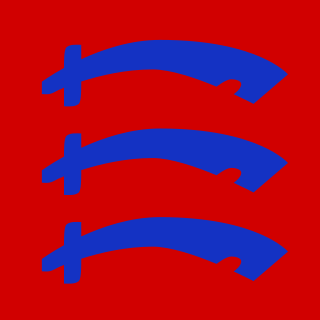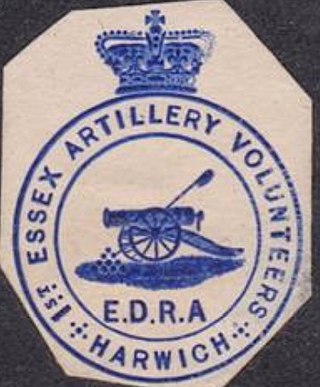The 45th Infantry Division was an infantry division of the Territorial Force, part of the British Army. It was formed in the First World War as a duplicate of the 43rd (Wessex) Division and was originally formed as the 2nd Wessex Division in 1914–1915 before later being renamed as the 45th Division and the brigades numbered. It was sent overseas to India in December 1914 to relieve Regular Army units for service in France. The division remained there for the rest of the war, supplying drafts of replacements to the British units fighting in the Middle East and later complete battalions.
The 214th Brigade was an infantry formation of the British Army during World War I. It was raised as a second line brigade of the Territorial Force and initially assigned to the 71st Division for coast defence. Later it was reorganised as an all-arms brigade group for service in North Russia, but this was cancelled and it was reassigned to the 67th Division, a training and home defence formation, until the end of the war.
The 226th Infantry Brigade was a Home Service formation of the British Army that existed under various short-lived titles in both World War I and World War II.
221st Mixed Brigade was a Scottish Home Service formation of the British Army that served under various titles throughout World War I.

The 223rd Brigade was a Home Defence formation of the British Army in the First and the Second World Wars. It existed under several variations of the 223 Brigade title, and was eventually converted into an airborne formation.
71st Division was a short-lived infantry division of the British Army during the First World War. It served in the Home Defence forces and never went overseas.
The Essex Royal Horse Artillery was a Territorial Force Royal Horse Artillery battery that was formed in Essex in 1908. It saw active service during the First World War in Egypt and Palestine from 1916 to 1918, initially as field artillery with 52nd (Lowland) Division before being converted back to horse artillery and serving with the 2nd Mounted / 5th Cavalry Division. A second line battery, 2/1st Essex RHA, served on the Western Front in 1917 and 1918 as part of an Army Field Artillery Brigade.
The Glamorganshire Royal Horse Artillery was a Territorial Force Royal Horse Artillery battery that was formed in Glamorganshire in 1908. It saw active service during the First World War on the Western Front in 1917 and 1918 as part of an Army Field Artillery Brigade. A second line battery, 2/1st Glamorganshire RHA, served in England and Ireland before being broken up in January 1917. Glamorganshire RHA was not reconstituted in the post-war Territorial Force.
The Shropshire Royal Horse Artillery was a Territorial Force Royal Horse Artillery battery that was formed in Shropshire in 1908 from the Shropshire Battery of the 1st Shropshire and Staffordshire Artillery Volunteers, Royal Garrison Artillery of the Volunteer Force. It saw active service during the First World War on the Western Front in 1917 and 1918 as part of an Army Field Artillery Brigade. A second line battery, 2/1st Shropshire RHA, also served on the Western Front in 1917 and 1918 as part of another Army Field Artillery Brigade. It was reconstituted post-war as a medium artillery battery and served as such in the Second World War.
The Berkshire Royal Horse Artillery was a Territorial Force Royal Horse Artillery battery that was formed in Berkshire in 1908. It saw active service during the First World War in the Middle East, notably at Aden and in particular in the Sinai and Palestine Campaign, from 1915 to 1918. A second line battery, 2/1st Berkshire RHA, served on the Western Front in 1917 and 1918 as part of an Army Field Artillery Brigade. After the Armistice, it was reconstituted as a Royal Field Artillery battery of the Territorial Army (TA), later being expanded into a full heavy anti-aircraft (HAA) regiment that served during the Second World War in the Battle of Britain and Blitz, in the assault landings in North Africa, Sicily and Italy. Postwar, it continued in the TA until 1968.
The Warwickshire Royal Horse Artillery was a Territorial Force Royal Horse Artillery battery that was formed in Warwickshire in 1908. It was the first Territorial Force artillery unit to go overseas on active service, spending the whole of the First World War on the Western Front, mostly with 1st Cavalry Division and 29th Division. A second line battery, 2/1st Warwickshire RHA, also served on the Western Front in 1917 and 1918 as part of an Army Field Artillery Brigade. Post-war it was reconstituted as a Royal Field Artillery battery.

The IV Home Counties (Howitzer) Brigade, Royal Field Artillery was a new volunteer unit formed in Kent as part of the Territorial Force (TF) in 1908. It saw active service on the Western Front during World War I and was reconstituted as medium artillery in the interwar years. Later it converted to anti-aircraft artillery, in which role it served in The Blitz, North Africa and Italy during World War II and continued under various designations until its disbandment in 1969.
The IV East Anglian Brigade of the Royal Field Artillery was a unit of Britain's Territorial Force (TF) from 1908 to 1919. It served in the Sinai and Palestine Campaign during World War I.

The 1st Essex Artillery Volunteers was a unit of Britain's part-time auxiliary forces raised in Essex in 1860 in response to an invasion scare. It served under various designations as field artillery in Palestine during World War I. During World War II its units served as mountain artillery in Italy and as jungle artillery and medium artillery in Burma. Postwar it became an airborne unit until it was merged with other units in the 1950s.

The 1st Norfolk Artillery Volunteers was a unit of Britain's Volunteer Force raised in the County of Norfolk in 1859 as a response to a French invasion threat. It became part of the Territorial Force in 1908 and served under various designations as field artillery in Palestine during World War I, and as heavy anti-aircraft artillery in North Africa and Italy during World War II. It disappeared in a merger in 1955.
The 1st Suffolk Artillery Volunteers was a unit of Britain's Volunteer Force and Territorial Army from 1860 until 1955. Raised at Lowestoft in Suffolk, it served under various designations, as field artillery in Palestine during World War I and as heavy anti-aircraft artillery defending the UK during World War II.
The 1st Cinque Ports Artillery Volunteers was a part-time unit of the British Army's Royal Artillery from 1860 to 1956. Raised as coastal defence artillery, the unit later served as field artillery in Mesopotamia during World War I, and as anti-aircraft artillery during the Blitz and in the Middle East during World War II.
The Cheshire Artillery Volunteers was a brigade of Volunteer artillery units raised in the county of Cheshire in the mid-19th century. Their successors served as field artillery in Palestine during World War I and as anti-aircraft (AA) gunners in the Middle East in World War II. They continued in the air defence role in the Territorial Army until 1955.
The Cumberland Artillery was a group of Volunteer artillery batteries formed in the county of Cumberland, England, in 1860. They became part of the Royal Garrison Artillery, and when the Territorial Force was created in 1908 they formed a Royal Field Artillery howitzer brigade for the East Lancashire Division. In World War I the brigade served at Gallipoli and in Egypt, then was broken up amongst the divisional artillery: its batteries fought on the Western Front for the rest of the war. In the 1920s the Cumberland Artillery batteries combined with the Westmorland and Cumberland Yeomanry to form a new field regiment of the Royal Artillery that saw considerable action in World War II.

The IV South Midland Brigade of the Royal Field Artillery (RFA) was a unit of Britain's Territorial Force (TF) from 1908 to 1919. Recruited from Warwickshire, it served on the Western Front during World War I, when it was broken up to reinforce other units.



